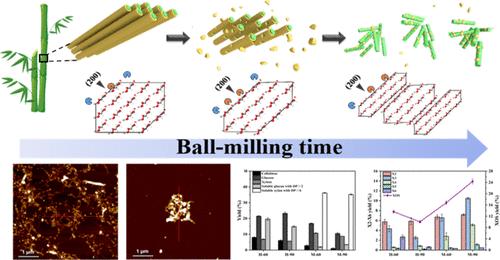通过球磨辅助双重酶处理实现竹纳米纤维素和单/寡糖的超分子调控和可控共生
IF 7.3
1区 化学
Q1 CHEMISTRY, MULTIDISCIPLINARY
引用次数: 0
摘要
从木质纤维素生物质中提取的纳米纤维素(NC)是一种很有前景的功能性应用材料。然而,用于制造纳米纤维素的传统化学和机械工艺对环境有害且能耗高,并可能不可避免地造成成分损失。本文提出了一种球磨辅助的绿色双酶处理竹浆的策略,以减少酶载量和处理时间,制备出具有不同形态和超分子结构的NC,以及单糖和木寡糖(XOS)的共生。内切葡聚糖酶(EG)和木聚糖酶以不同的负载比例用于调整 NC 的物理化学结构。机理研究表明,在较短的球磨时间内,通过保留半纤维素可实现纳米纤维化,而较长的球磨时间则可加强纤维的解构,从而暴露出有利于后续酶水解的纤维素疏水表面。该方法随后被应用于竹全纤维素和微晶纤维素(MCC)/木聚糖模型,获得了 23.2% 的葡萄糖、24.4% 的 XOS 和 21.5% 的 NC 的最高产量。竹全纤维素生产的NC具有高达55.1的高纵横比,而MCC生产的NC则是具有纤维素II异构体的球形NC。所提出的球磨辅助双酶处理方法可为竹多糖的高值转化和更全面利用提供理论指导。本文章由计算机程序翻译,如有差异,请以英文原文为准。

Supramolecular Regulation and Controllable Coproduction of Bamboo Nanocellulose and Mono/Oligosaccharides via Dual-Enzymatic Treatment Assisted by Ball Milling
Nanocellulose (NC) derived from lignocellulosic biomass has served as a promising material for functional applications. However, conventional chemical and mechanical processes for NC fabrication are environmentally harmful and energy intensive and may inevitably cause component loss. Herein, a green dual-enzymatic treatment assisted by ball milling strategy was proposed for bamboo pulp to produce NC with varied morphologies and supramolecular structures, as well as the coproduction of monosaccharides and xylooligosaccharides (XOS) with reduced enzyme loading and treatment time. Endoglucanase (EG) and xylanase at various loading ratios were used for adjusting the physical–chemical structures of NC. Mechanistic studies showed the accomplishment of nanofibrillation under shorter ball milling time via retention of hemicelluloses, while longer ball milling time intensified fibril deconstruction, thus exposing cellulose hydrophobic surfaces favorable for subsequent enzymatic hydrolysis. The method was subsequently applied to bamboo holocellulose and microcrystalline cellulose (MCC)/xylan models, which obtained the highest yields of 23.2% glucose, 24.4% XOS, and 21.5% NC. Bamboo holocellulose produced NC with a high aspect ratio of up to 55.1, while MCC produced spherical NC with cellulose II allomorph. The proposed ball-milling-assisted dual-enzymatic treatment can provide theoretical guidance for high-value conversion and more complete utilization of bamboo polysaccharides.
求助全文
通过发布文献求助,成功后即可免费获取论文全文。
去求助
来源期刊

ACS Sustainable Chemistry & Engineering
CHEMISTRY, MULTIDISCIPLINARY-ENGINEERING, CHEMICAL
CiteScore
13.80
自引率
4.80%
发文量
1470
审稿时长
1.7 months
期刊介绍:
ACS Sustainable Chemistry & Engineering is a prestigious weekly peer-reviewed scientific journal published by the American Chemical Society. Dedicated to advancing the principles of green chemistry and green engineering, it covers a wide array of research topics including green chemistry, green engineering, biomass, alternative energy, and life cycle assessment.
The journal welcomes submissions in various formats, including Letters, Articles, Features, and Perspectives (Reviews), that address the challenges of sustainability in the chemical enterprise and contribute to the advancement of sustainable practices. Join us in shaping the future of sustainable chemistry and engineering.
 求助内容:
求助内容: 应助结果提醒方式:
应助结果提醒方式:


